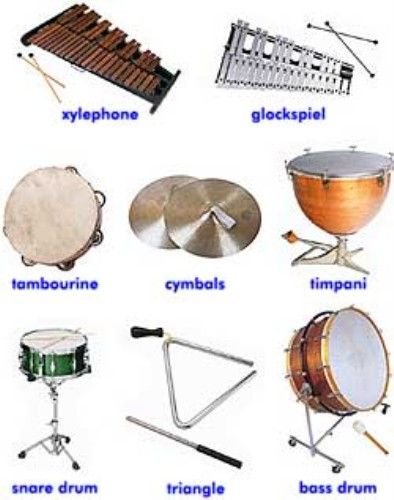The Orchestra

An Orchestra is simply a group of musicians that play together. They can be smaller (chamber) orchestras or ones that are larger called "symphony orchestras" (and in modern times shortened just to "symphony" sometimes). Orchestra musicians are divided into what are called "sections" depending on what types of instruments they play. Typically these sections of instrument families are string instruments, brass instruments, woodwind instruments and percussion. As the pieces, like a symphony for example, have more variety in terms of the instrumentation, they require bigger ensembles that will then have more sections. This chart shows how these sections are typically arranged when the musicians play together in a larger symphony orchestra. The person who stands in front of them and leads the orchestra is called the "conductor".

String instruments are just that - musical instruments with strings that are played either with the fingers or with a bow to make the musical sounds. In an orchestra of any size, usually the banjo, guitar or electric guitar pictured will be a solo instrument playing with the ensemble. They are not regular members of a symphony or chamber orchestra. A harp is also not used for all pieces of music, but does have its place in the orchestra seating chart.

Instruments of the brass family are usually, but not always, made of brass. Certain horns that are classified as brass instruments even though they are mostly made of wood. But in an orchestra you will mostly see the instruments to the right which are made of brass. The term "brass" has come to mean an instrument where the musical notes are produced by the simultaneous vibration of the air blown into a tubular shape and the vibration of the player's lips. Modern brass instruments like the tuba, French horn, and trumpet also have valves that change the pitch of notes when the player presses them. The trombone uses a slide to change the pitches.

Woodwind instruments are not all made of wood - note to the right that the flute and saxophone are made of metal. But the one thing they do have in common is that sound is produced by blowing "wind" or air into the instrument. In the case of the oboe, clarinet, bassoon, and saxophone, the sound is made by blowing into an oscillating reed (traditionally made out of woody cane) rather than lips vibrating in a mouthpiece cup as with the brass instruments. The flute is also blown into, but has no reed. The flutist blows a focused stream of air below the edge of a hole in a cylindrical tube that splits the airstream as it enters the tube. The flute used in a modern orchestra is called a transverse flute because it is held horizontally.

Percussion instruments are those where sound is produced by striking or brushing the instrument. This can be done with the hand, but also may be done with a stick called a "mallet" or "beater". Along with the human voice, this is the oldest family of instruments. They can be pitched (as in the timpani) or unpitched (as in a snare drum). The most common orchestral percussion instruments are pictured to the left. But you should also know that keyboard instruments like the piano are also percussion instruments, because the sound is produced by hammers striking the strings.
